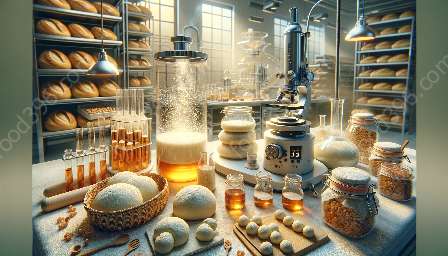Understanding the interplay between dough rheology, bread fermentation, and dough development is essential for mastering the art of bread making. This comprehensive guide offers insights into the fascinating science and technology behind producing the perfect loaf of bread. Learn how these elements come together to create the sensory delight we know as bread.
Dough Rheology: The Science Behind Bread Making
At the heart of bread making lies the complex science of dough rheology. Rheology, the study of how materials flow and deform, plays a critical role in determining the texture, structure, and overall quality of bread. The physical properties of dough, such as elasticity, viscosity, and extensibility, are influenced by the rheological behavior of its protein and starch constituents.
Protein Networks and Gluten Development
Gluten, a key component in dough, provides the necessary structure and strength to the bread. When water is added to flour, gluten proteins undergo a process called hydration, leading to the formation of gluten strands. These strands interconnect to create a strong, elastic network, giving the dough its characteristic stretchiness and resilience. Understanding the dynamics of gluten formation is crucial for achieving the desired texture in the final baked product.
Role of Fermentation in Dough Development
Bread fermentation, a natural biological process driven by yeast and lactic acid bacteria, is an integral part of dough development. During fermentation, microorganisms metabolize sugars in the dough, producing carbon dioxide gas and organic acids. This gas production results in dough expansion, while the acids contribute to flavor development and dough maturation. The controlled interaction of fermentation with dough rheology is pivotal for creating light, airy bread with a well-developed crumb structure.
Dough Development: A Precise Balancing Act
Effective dough development involves a delicate balance of mixing, fermentation, and mechanical manipulation. Proper mixing ensures the even distribution of ingredients and facilitates gluten formation, leading to improved dough strength and extensibility. The fermentation process, guided by time and temperature, allows for the complex interplay of enzymatic activity and gas production, shaping the dough's rheological properties. Furthermore, the mechanical handling of the dough, including folding and shaping, influences its development and final structural characteristics.
Impact of Water Content and Temperature
The water content and temperature of the dough profoundly impact its rheological behavior and the subsequent bread quality. Optimal hydration levels ensure the formation of a balanced and stable dough, while temperature control during fermentation dictates the rate of yeast and enzyme activity. Understanding these parameters is essential for achieving the desired dough consistency and structure.
Baking Science & Technology: The Final Crucial Steps
The culmination of dough rheology, fermentation, and dough development is the art of baking. The application of baking science and technology brings together the concepts of heat transfer, oven spring, crust formation, and crumb texture. Heat triggers the expansion of gas within the dough, leading to the sought-after oven spring, while temperature control and steam injection influence crust color, thickness, and crispness. The intricate science behind these processes defines the nuances of bread baking and the sensory experience it offers.
Mastery of Bread Making: A Harmonious Symphony
Mastering the art of bread making requires a holistic understanding of dough rheology, bread fermentation, dough development, and the principles of baking science and technology. Achieving the perfect loaf involves orchestrating a symphony of ingredients, processes, and parameters to produce bread with exceptional flavor, texture, and appearance. Embracing the scientific and technical aspects of bread making enhances the journey from raw ingredients to a finished, delectable loaf of bread.


